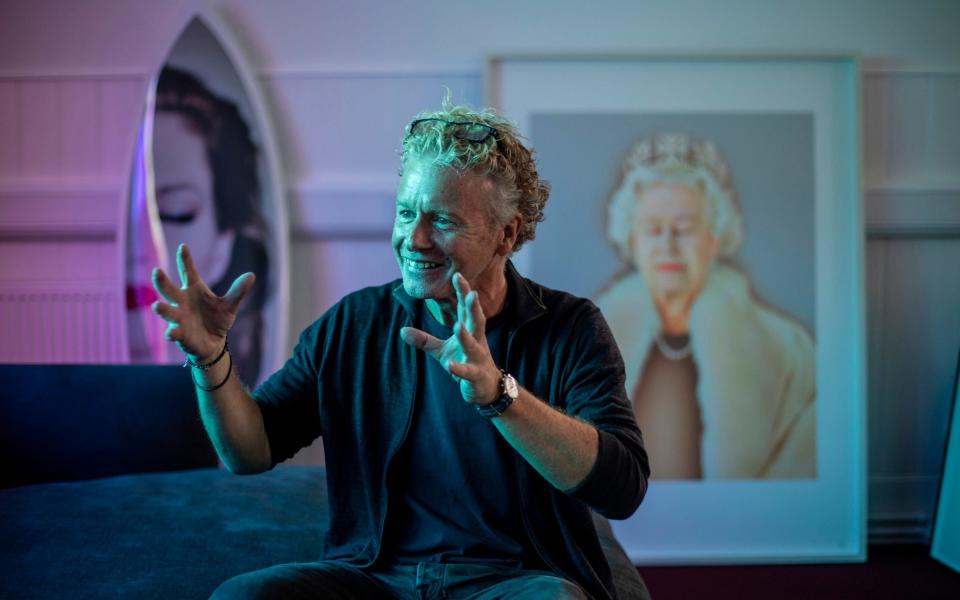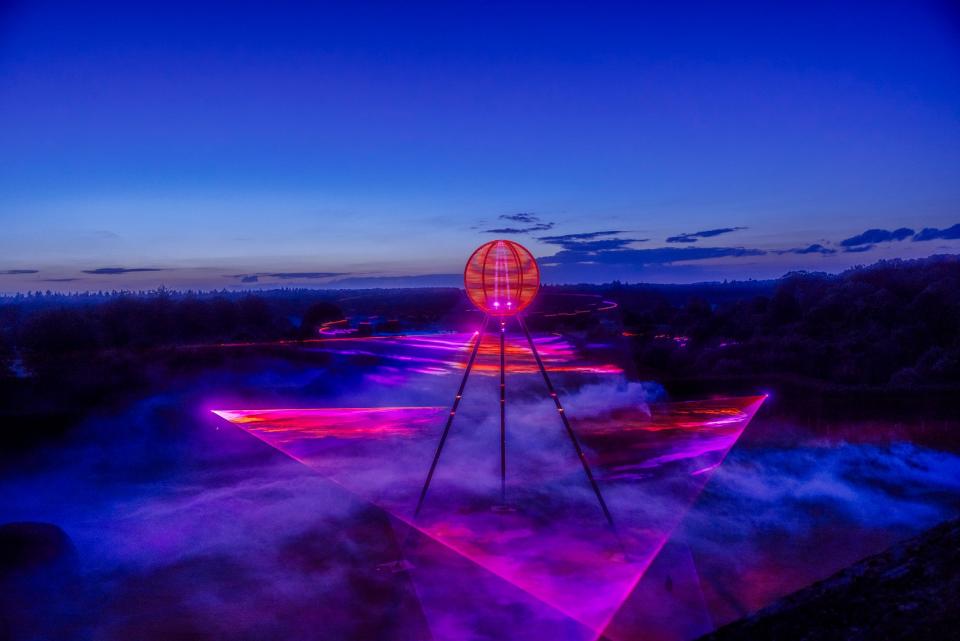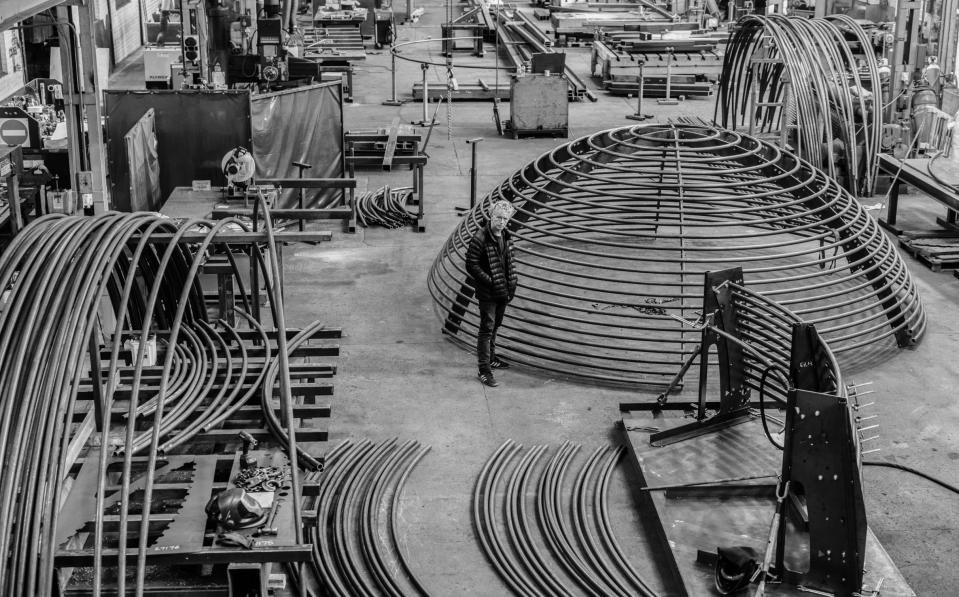Chris Levine on photographing the Queen: ‘When she left, I just lay on the floor’

- Oops!Something went wrong.Please try again later.
- Oops!Something went wrong.Please try again later.
- Oops!Something went wrong.Please try again later.
- Oops!Something went wrong.Please try again later.
- Oops!Something went wrong.Please try again later.
Chris Levine remembers standing with Boy George, John Galliano and a host of other celebs watching the dazzling laser show he’d put on for Kate Moss’s 40th birthday party in 2014. He started chatting to another guest, who turned out to be Lord Cholmondeley, owner of Houghton Hall, Norfolk, which is famous for its summer exhibitions, recent subjects of which have included Anish Kapoor, Richard Long and Damien Hirst. Cholmondeley was evidently impressed by Levine because this year, when he decided to hold Houghton’s first winter art show, he commissioned him to do it.
So who is Chris Levine? He is mainly known for Lightness of Being, his 2004 photograph of the Queen with her eyes shut, which is a staple of the National Portrait Gallery, but there is an awful lot more to him than that. I went to see him at his studio in the old schoolhouse of a straggling dormitory village somewhere in Hampshire. It seems an unlikely setting for a cutting-edge artist, but he and his family moved to the area to be near the children’s school, Bedales, and he got fed up with commuting to his studio in London. Only a silver-painted van parked outside suggests that there are excitements within.
Levine comes leaping out to greet me, a tousle-headed Puck who looks much younger than 61, talking nineteen to the dozen. The studio contains some of his prints I recognise – the Queen, Kate Moss, Grace Jones, the Dalai Lama – but also, disconcertingly, a bright green laser light running round the wall and sometimes onto his cheek. I wish he would switch it off, but of course we are here to discuss his art and his art is all about light. He signs his emails “Be Light!”
Levine is keen to talk about the installation, 528 Hz Love Frequency, he is designing for Houghton Hall. The centrepiece is a vast sphere mounted on a tripod that stands higher than the house. By day it uses natural light, but at night it will put out lasers – one locked on to the North Star – “So the configuration is a cosmic piece of art, essentially. And it will emit a beam of sound on the solfeggio scale, which will go right to the chakras of anyone standing underneath, to draw them into a meditative state. If everyone meditated, there’d be no more wars.”
His torrent of talk is a unique blend of science, art and pure woo-woo – ley lines and the Great Pyramid of Giza come into it somewhere – which is hard to follow, but curiously compelling. The art and science come from his parents – his father was an engineer, his mother a painter – but the woo-woo is all his own. He was born in Canada because his father happened to be working there, but returned to England when he was two. The family moved round so much that he had been to 10 different schools by the time he was 11 and found it hard always being the new boy. His most vivid memory is of being taken to the Science Museum when he was about nine and being completely entranced by a hologram of Dennis Gabor, the inventor of holography.

“You’d press the button and he was there and then he was not there,” he says. “And I loved that moment of having to question, what’s real?” Levine has been hooked on holograms ever since. He was good at drawing, so he did a BA in fine art at Chelsea School of Art and an MA in computer graphics at Central St Martins, where he was able to develop his interest in holography. Actually, he says, he was really just waiting for his pop group, Triangle, to take off, but it never did – he was the drummer, but could never find anywhere to practise because he made such a racket.
So he stuck with holograms and mainly did advertising work because advertisers had the money to put into experimental techniques. In 1986, he worked with hologram technicians at Loughborough University and made what was then the biggest hologram in the world, of the Michelin Man, 5ft x 3ft. But while his career was taking off, so too was his drinking (his father and his grandfather had been alcoholics), and he ended up in rehab. He had his last drink on May 29, l989. “Since then, I’ve been looking for other ways of getting high in my work.”
He also discovered meditation. He was “struggling” when a friend suggested he go on a silent retreat to Kathmandu. There he learnt about Vipassana meditation, which he claims “saved my life”. Since then, he has gone on Vipassana retreats every year, but nowadays goes to a centre in Hereford rather than Kathmandu, because he thinks Nepal was a bit of a distraction. Does his wife go with him? “No. Gardening is her form of meditation. But I really needed it. I think I’d spontaneously combust today if I wasn’t able to get still on a regular basis.”

His career was chugging along nicely when in 2004 he got a phone call asking if he would like to do a portrait of the Queen. He thought at first it was a joke, but it wasn’t – Jersey Heritage Trust wanted to celebrate the island’s 800 years of allegiance to the Crown, and apparently one of the curators had suggested him. He was given a completely free hand and told the Queen would sit for him for an hour and a half in the Yellow Drawing Room at Buckingham Palace.
Angela Kelly, the Queen’s assistant and dresser, asked what he would like Her Majesty to wear. Levine specified a very simple plain dress and a selection of capes, so he could change the look. But “when she put the ermine on, it was magical”. He was also taken to the Royal Collection to choose a crown, and selected the same diadem that Lucian Freud had chosen for his own portrait of the Queen in 2001. But on the morning of the shoot, the palace rang to ask, did he really need the crown, because there was a security problem – security staff were tied up with President Bush’s visit. “And normally I would have said ‘Fine’, but something in me made me say I really needed it. So Angela Kelly just brought it over in a big jewel box and put it on the mantelpiece, and when Her Majesty arrived, she opened the box and put it on in front of the mirror. I thought there’d be some ceremony or ritual involved, but not at all.”

Levine had been told to explain to the Queen what he was doing, because normally she’d expect to see just an easel, whereas now there were all these laser scanners and a camera on rails and a team of technicians. So he explained. “But she wasn’t giving anything away and it was quite unnerving, because I thought, ‘Does she get this? Or am I dreaming?’ But I suppose she has this mechanism to protect herself – which gave me the title, Equanimity. So we did the sitting, and when she left the room I just lay on the floor and breathed a great sigh of relief. I was still lying there when one of her aides came in and said, ‘Well, Her Majesty enjoyed that and if you would like another sitting, you only have to ask.’”
The first sitting was good but the second was better, because he had the benefit of hindsight. He raised the camera angle and told Her Majesty not to look into the camera but beyond it, at a small ultraviolet cross he’d hung behind the camera. And, crucially, he told her to rest her eyes between takes. “For the 3D work we had a camera that moved along a track and took 200 frames in seven seconds, and she had to keep still for that. Then there’s a pause while we reset, recalibrate, and I suggested she close her eyes to rest them. And that’s when I took the photo of her with her eyes shut, and that’s the one that resonated, that went into pop culture.”
The eyes-open portrait, Equanimity, was used by the Jersey Trust and on the cover of Time magazine, but it’s the Queen with eyes shut, Lightness of Being, that has become an icon. The National Portrait Gallery calls it “the most evocative image of a royal by any artist”, and it has been endlessly reproduced.
Does Levine ever resent being known as the Queen guy? No, he says, he is grateful for the boost, but he hopes that people will gradually come to see and appreciate more of his work. Hence his excitement about Houghton Hall. Of course, the portrait of the Queen will be there, along with some of his famous lightbox portraits, but the main event will be the huge light sculpture on the lawn. “Whatever else I’m doing, it’s going to be the best f---ing laser show you’ve ever seen!”
Chris Levine, 528 Hz Love Frequency, is at Houghton Hall, Norfolk (houghtonhall.com) on December 23

